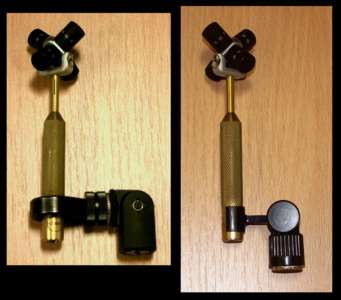Hardware Assembly
Cabling
The output from the TetraMic is four unbalanced signals from the four capsules. It is not recommended to take these signals further than about 6m (20 ft). Cables terminated in miniature 6-pin XLR plugs are available in 1.8m (6 ft), 3m (10 ft) and 6m (20 ft) lengths.
There are two ways to terminate the miniature cable run. The simplest, which will be available shortly, will be to use Core Sound's 4Mic, which is a four-channel mic preamp and ADC combination. The 4Mic provides the power required by the TetraMic, has a mode in which the mic amp gains are accurately matched, and can output the four capsule signals either on two S/PDIF outputs, or multiplexed on a single S/PDIF output running at double speed.
(Update: the 4Mic never went into production, as other equipment with matched channel gains was found satisfactory.)

Conversion to Balanced
Until the 4Mic is available, and in any case for some users, there is an alternative method of transferring the signals. A breakout cable is available which splits the single four-channel output into four mono outputs, still on miniature plugs; and these can be plugged into four PPAs (Phantom Power Adapters) which convert the signals to balanced on standard XLRs, and which also supply power to the TetraMic. My breakout cable is 0.3m (1 ft) long, though the web site says they are 0.6m (2 ft) long. The photo shows the breakout cable, with the four PPAs, connected directly to the mic; usually one of the extension cables would be in between, so that the PPAs sit quietly on the floor at the base of the microphone stand, rather than being suspended in full view.
(Update: The recently released PPAc combines the four PPAs into a single package, as well as giving Cat5 capability; I have added a page describing this.)

Mounts
The shockmount is very neat. It is a pair of rubber rings moulded as a unit with rubber links between. It is most flexible in the directions that a stand is most likely to move, so is probably effective in most situations. My recording is usually in places with solid (typically stone) floors, so I don't get to exercise its capabilities too hard. The clip has a slight amount of flexibility as well, just because it is so petite.
The left-hand photo shows the shockmount with the additional Neumann SG-5 swivel mount that I bought.


